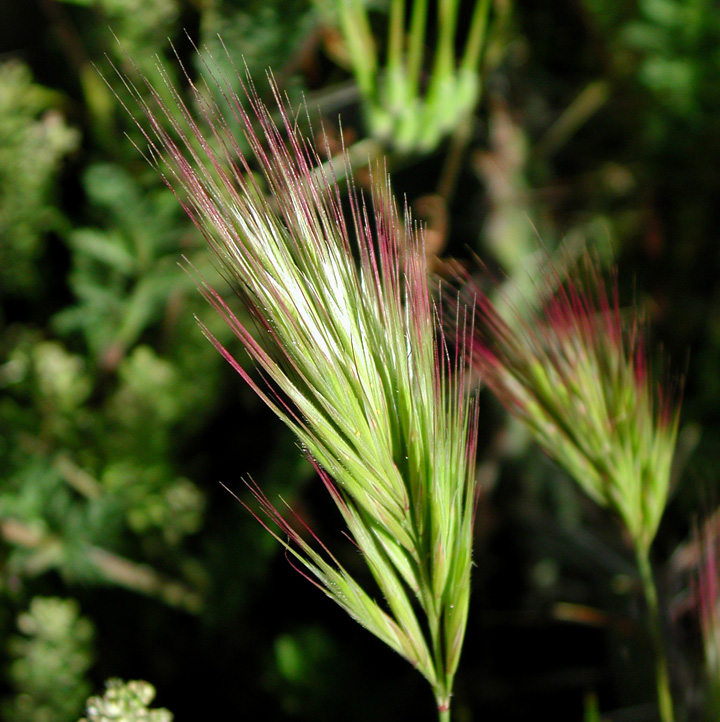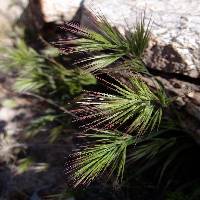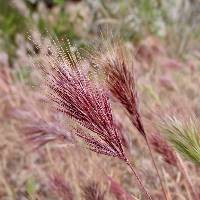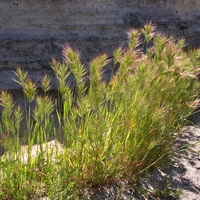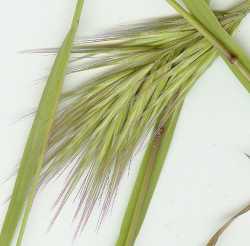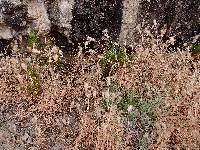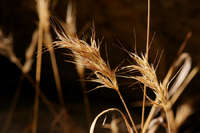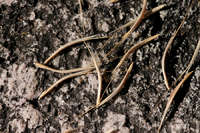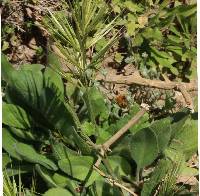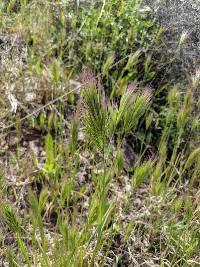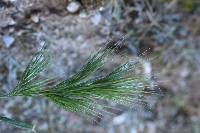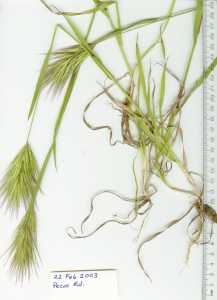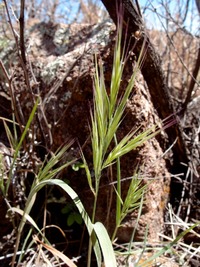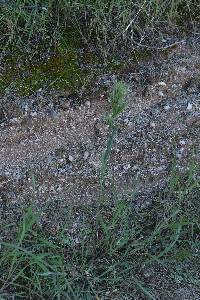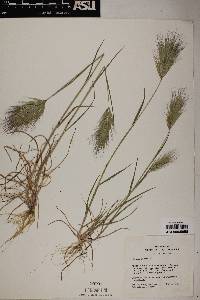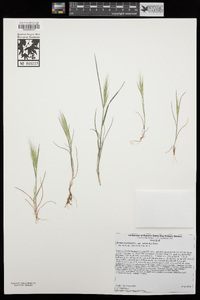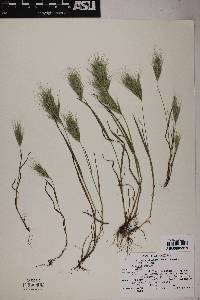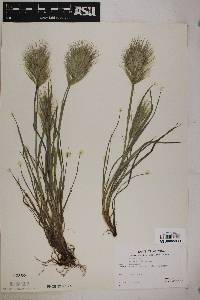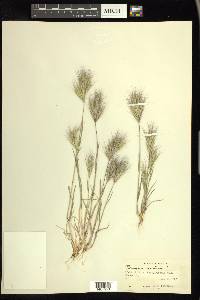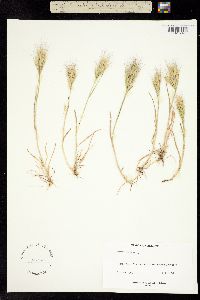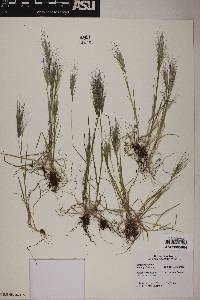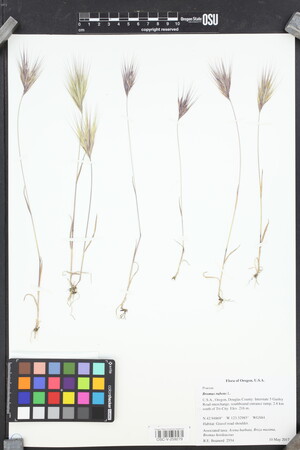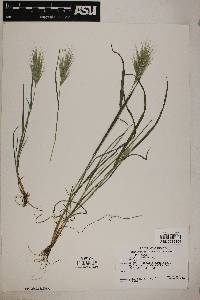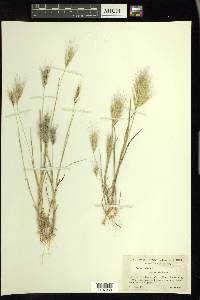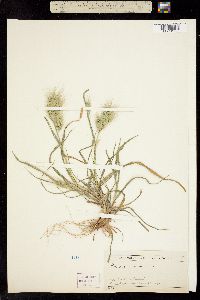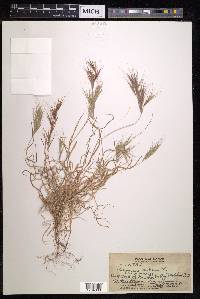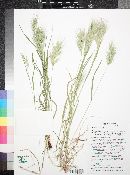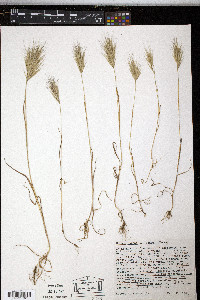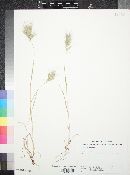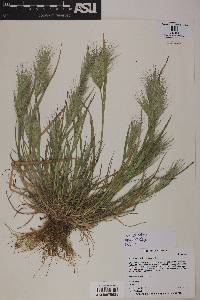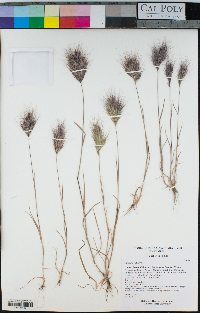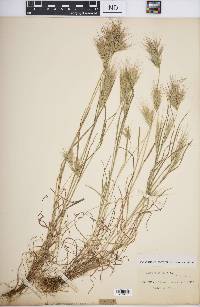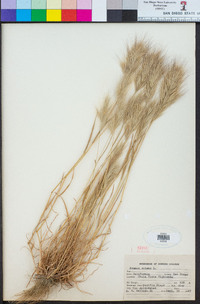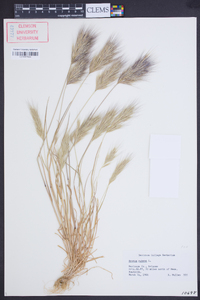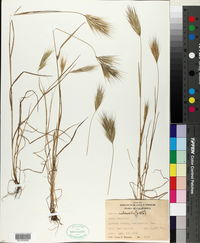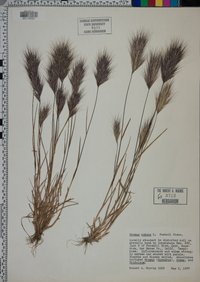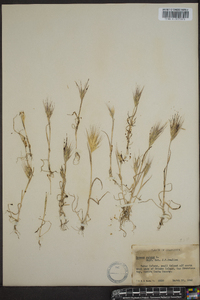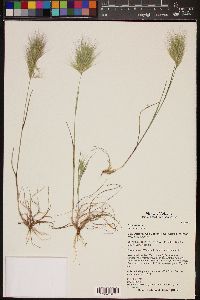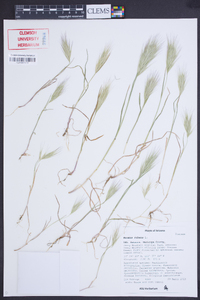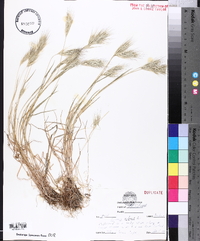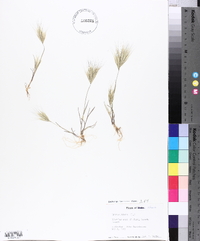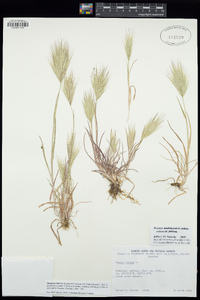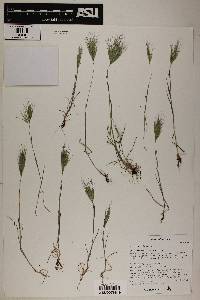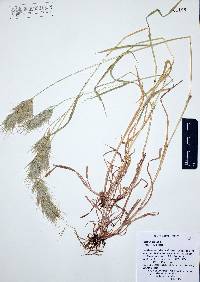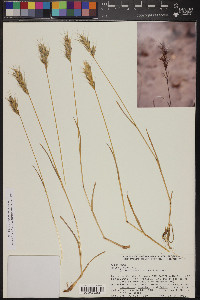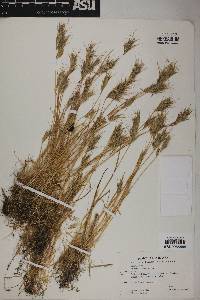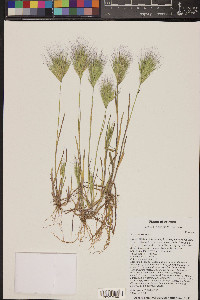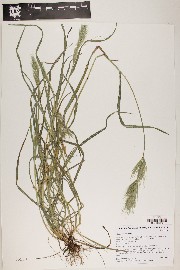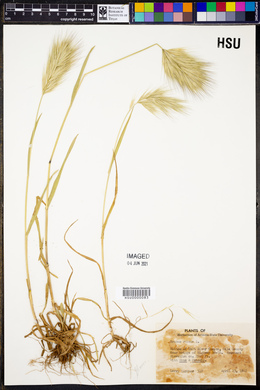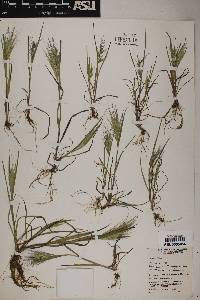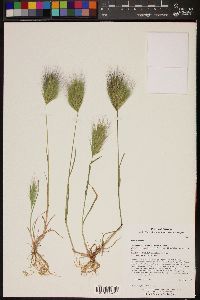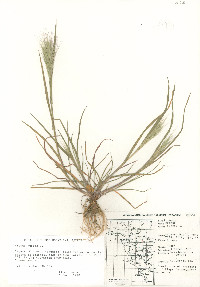
|
|
|
|
Family: Poaceae
Red Brome, more...foxtail chess, foxtail brome (es: bromo rojo)
[Anisantha rubens (L.) Nevski, moreBromus madritensis subsp. rubens (L.) Husnot, Bromus matritensis subsp. rubens , Bromus scoparius var. rubens (L.) St.-Amans, Festuca rubens (L.) Pers., Zerna rubens (L.) Grossh.] |
Plants annual. Culms 10-40 cm, erect or ascending, often puberulent below the panicle. Sheaths softly pubescent to pilose; auricles absent; ligules 1-3(4) mm, pubescent, obtuse, lacerate; blades to 15 cm long, 1-5 mm wide, flat, pubescent on both surfaces. Panicles 2-10 cm long, 2-5 cm wide, erect, dense, often reddish-brown; branches 0.1-1 cm, ascending, never drooping, not readily visible, with 1 or 2 spikelets. Spikelets 18-25 mm, much longer than the panicle branches, densely crowded, subsessile, with parallel sides or widening distally, moderately laterally compressed, with 4-8 florets. Glumes pilose, margins hyaline; lower glumes 5-8 mm, 1(3)-veined; upper glumes 8-12 mm, 3-5-veined; lemmas 10-15 mm, linear-lanceolate, pubescent to pilose, 7-veined, rounded over the midvein, margins hyaline, apices acuminate, teeth 1-3 mm; awns 8-20 mm, straight, reddish, arising 1.5 mm or more below the lemma apices; anthers 0.5-1 mm. 2n =14, 28. Bromus rubens is native to southern and southwestern Europe. It now grows in North America in disturbed ground, waste places, fields, and rocky slopes, from southern Washington to southern California, eastward to Idaho, New Mexico, and western Texas. It was found in Massachusetts before 1900 in wool waste used on a crop field; it is not established there.- The record from New York represents a rare introduction. ©Utah State University; reproduced with permission. Dr. David Bogler, USDA NRCS PLANTS Database Annuals, Terrestrial, not aquatic, Stems nodes swollen or brittle, Stems erect or ascending, Stems geniculate, decumbent, or lax, sometimes rooting at no des, Stems caespitose, tufted, or clustered, Stems terete, round in cross section, or polygonal, Stem internodes hollow, Stems with inflorescence less than 1 m tall, Stems, culms, or scapes exceeding basal leaves, Leaves mostly cauline, Leaves conspicuously 2-ranked, distichous, Leaves sheathing at base, Leaf sheath mostly closed, Leaf sheath hairy, hispid or prickly, Leaf sheath and blade differentiated, Leaf blades linear, Leaf blades 2-10 mm wide, Leaf blades mostly flat, Leaf blades more or less hairy, Ligule present, Ligule an unfringed eciliate membrane, Inflorescence terminal, Inflorescence a contracted panicle, narrowly paniculate, branches appressed or ascending, Inflorescence a dense slender spike-like panicle or raceme, branches contracted, Inflorescence solitary, with 1 spike, fascicle, glomerule, head, or cluster per stem or culm, Inflorescence branches more than 10 to numerous, Flowers bisexual, Spikelets pedicellate, Spikelets laterally compressed, Spikelet s with 3-7 florets, Spikelets solitary at rachis nodes, Spikelets all alike and fertille, Spikelets bisexual, Spikelets disarticulating above the glumes, glumes persistent, Spikelets disarticulating beneath or between the florets, Rachilla or pedicel glabrous, Glumes present, empty bracts, Glumes 2 clearly present, Glumes equal or subequal, Glumes distinctly unequal, Glumes shorter than adjacent lemma, Glumes 1 nerved, Glumes 3 nerved, Lemmas thin, chartaceous, hyaline, cartilaginous, or membranous, Lemma 5-7 nerved, Lemma glabrous, Lemma apex dentate, 2-fid, Lemma distinctly awned, more than 2-3 mm, Lemma with 1 awn, Lemma awn 1-2 cm long, Lemma awn 2-4 cm long or longer, Lemma awned from tip, Lemma awn from sinus of bifid apex, Lemma awn subapical or dorsal, Lemma margins thin, lying flat, Lemma straight, Palea present, well developed, Palea membranous, hyaline, Palea shorter than lemma, Palea longer than lemma, Palea 2 nerved or 2 keeled, Palea keels winged, scabrous, or ciliate, Stamens 3, Styles 2-fid, deeply 2-branched, Stigmas 2, Fruit - caryopsis, Caryopsis ellipsoid, longitudinally grooved, hilum long-linear, Caryopsis hairy at apex.
FNA 2007, Gould 1980 Common Name: red brome Duration: Annual Nativity: Non-Native Lifeform: Graminoid General: Winter annual grass with erect to ascending, often puberulent stems, 10-40 cm tall, each topped with a dense panicle of large, long-awned spikelets. Vegetative: Lower sheaths and blades pubescent; sheath closed to within a few cm of ligule; ligule membranous, irregularly toothed, 1-2.5 mm long; blades flat, pubescent on upper and lower surfaces, 1-2 mm wide, 2-6 cm long. Inflorescence: Panicle dense and several-flowered, 4-8 cm long including awns; branches short and erect, generally hidden within the panicle; spikelets, especially the awns, usually dark reddish brown or purple-tinged at maturity; spikelets ascending, 2 cm long, densely crowded, subsessile, with 4-8 florets; lemma margins hyaline; awns 2 cm long, curving as the plant dries out. Ecology: Found on overgrazed rangeland and otherwise disturbed habitat; 0-7,000 ft (0-2134 m); flowers in the spring. Distribution: Widespread in the western US from OR south through CA and east to TX; south to c MEX. Notes: An exotic, annual brome distinguished by its inflorescence of tufts of densely-crowded spikelets clustered at the top of plants with long reddish awns. Often forms dense stands or carpets, especially in sandy areas or disturbed ground. Widespread, spreads with fire and overgrazing, edible by livestock only while young and vegetative. Ethnobotany: Unknown Etymology: Bromus comes from Greek bromo for stinking, while rubens means red, referring to the color of the awns. Synonyms: Anisantha rubens, Bromus madritensis subsp. rubens, Bromus matritensis subsp. rubens Editor: SBuckley 2010, FSCoburn 2014, AHazelton 2015 Annual 1-5(-8) dm, with fine retrorse pubescence; blades narrow, 1.5-4(-5) mm wide, sometimes involute; ligule 1-2.5(-3) mm; infl contracted, ovoid, short, to 10 cm, often
purplish, the short branches and pedicels stout, ascending; spikelets 18-25(-30) mm, 3-8(-10)-fld, scaberulous to finely hirsute; glumes subulate, the first (5-)6.5-10 mm, 1-veined, the second 9-13 mm, 3-veined; lemmas subulate, 12-17 mm, 0.5-1.2 mm wide in side-view, 3- or 5-veined, the slender apical teeth 4-5 mm; awns 12-20(-24) mm, straight or slightly arcuate-spreading; palea shorter than the lemma; anthers 0.4-1 mm; 2n=28. Native of the Mediterranean region, widely intr. as a weed in arid w. U.S., and casually adventive with us. Gleason, Henry A. & Cronquist, Arthur J. 1991. Manual of vascular plants of northeastern United States and adjacent Canada. lxxv + 910 pp. ©The New York Botanical Garden. All rights reserved. Used by permission. |
|
|
|
This project was made possible in part by the Institute of Museum and Library Services [MG-70-19-0057-19].
Powered by Symbiota

